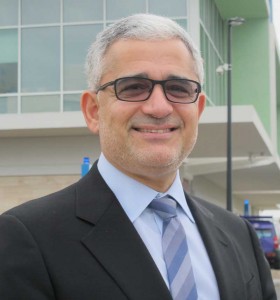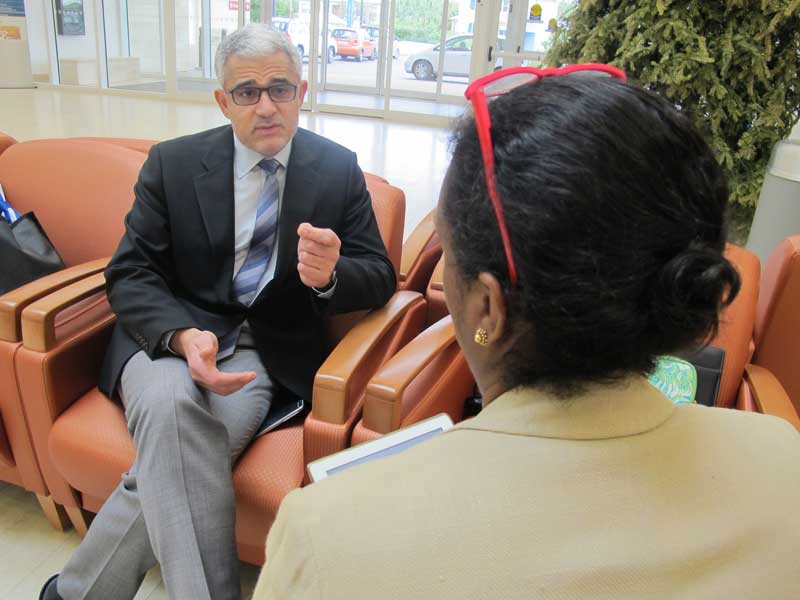BHB Hosts ‘Robotic’ Cardiac Surgery Lecture
 Imagine having heart surgery and not having your chest cut wide open?
Imagine having heart surgery and not having your chest cut wide open?
It’s no longer just wishful thinking, but there is only a handful of surgeons in the world who do the procedure.
As part of Bermuda Hospital Board’s [BHB] Continuing Medical Education programme, one of that handful lectured at BHB last month on the technique.
Dr Husam Balkhy [pictured] said there are only about 15 surgeons in the world who perform robotic cardiac surgery and that its use is certain to expand.
The Director of Robotic and Minimally Invasive Cardiac Surgery and Associate Professor of Surgery at the University of Chicago, Dr Balkhy said the technique provides surgeons “the ability to perform standard heart surgery procedures without opening the patient’s chest.”
He said procedures such as coronary bypass and heart valve repair or replacement can be done totally endoscopically, avoiding the need to break the breast bone.
To access the heart, small incisions are made between ribs on the right or left side of the chest, depending on the procedure. Three to five small ports measuring about a centimeter each are placed in the incisions, and a scope and microscopic instruments are inserted into them.
“Although this is called robotic surgery, no robot does the procedure,” said Dr Balkhy. “The surgeon does the surgery by controlling and manipulating the microscopic instruments through a computerised system.”
The patient is fully anesthetised and is in the room with the surgeon. “My patients are just a few feet away from me,” he said.
Using a computer console in the operating room, Dr Balkhy is able to see the affected area in the patient’s body and carefully maneuver the microscopic instruments to mend the problem.
The very delicate operation is not faster than having the same procedure done by opening the chest. “In fact it tends to be a bit longer,” said Dr Balkhy. “This is where the skill of the surgeon comes into play.”
And because the procedures are done endoscopically there are only a few small incisions that have to heal, versus the broken breastbone required for major heart surgery. This means recovery times are quicker. And according to Dr Balkhy there’s also less pain and patients return to full functionality faster.
“Recovery times for the robotic procedure are two days in hospital and two to three weeks full return to work versus five to seven days in hospital and three to four months return to work. Additionally there is significant scarring with major surgery,” he said.
According to Dr Balkhy the minimally invasive procedure also helps patients psychologically. He said this mental aspect is particularly evident in young patients where self-image and physical self-awareness are impacted by regular heart surgery.
He said many people are forced to grapple with their mortality when facing heart surgery but with the endoscopic procedure, because it is less invasive, this mental turmoil tends to be greatly diminished.
Are there any circumstances where this procedure should not be used? According to Dr Balkhy it’s not usually a good option for people who need to have more than one problem addressed or for people who have had lung surgery.
This is because scar tissue may have formed that impedes the ability to properly use the endoscopic equipment. But he said it’s particularly beneficial to previous heart surgery patients, diabetics, and obese and frail people. There is a high risk of infection in these groups, and with that there can be long therapies and multiple surgeries.
“The risk of infection is almost zero with robotic surgery,” said Dr Balkhy. He also noted that emphysema patients can benefit because heart surgery that entails breaking the breast bone often impacts the way the chest moves. This is avoided by not cutting the breast bone,” he said.
With such significant recovery time benefits the question is: Why would anyone not chose this method? Dr Balkhy said the main reason people don’t chose it is because they do not know about it. He said there are only about 15 to 20 programmes that offer it and noted that the programme at the University of Chicago, which he heads, is broad spectrum, covering a variety of cardiac procedures that can be done with the technology.
Is it difficult to get an appointment for the procedure? According to Dr Balkhy there’s not a backlog of patients waiting for the operation.
“We have a two tier system – urgent and elective,” he said. “We can always fit someone in right away if it is urgent and we can schedule electives.
“We have patients from other states and other countries, like the Middle East and Greece. I have not had a patient from Bermuda,” he added.
While the procedures could be carried out remotely, Dr Balkhy said he would not recommend it at this stage. He did note, however, that to prove that it is possible the manufacturers of the equipment did arrange an event where a surgeon in Paris, France, carried out a cardiac operation on a patient in New York City.
“But specialists need to be on hand. It is not feasible on a routine basis,” he said.
Read More About
Category: All




Magine dat….i’ll magin dat we should take the step…be a sin not to endeavor science…after all…i think therefor i am…plural that.
What about the possibility of CR? Can this equipment be effectively sterilised against contamination by antibiotic resistant superbugs responsible for numerous deaths in hospitals using contaminated endoscopes?
CRE not CR
CRE is carbapenem-resistant Enterobacteriaceae, a particularly virulent antibiotic resistant bacteria which has been found to be responsible for the deaths of patients who have undergone procedures employing endoscopes.